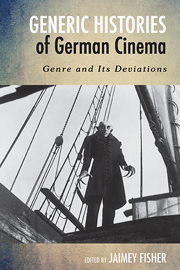Book contents
- Frontmatter
- Contents
- Acknowledgments
- Introduction: Toward Generic Histories—Film Genre, Genre Theory, and German Film Studies
- 1 Parallel Modernities: From Haunted Screen to Universal Horror
- 2 The Essay Film and Its German Variations
- 3 The Limits of Futurity: German Science-Fiction Film over the Course of Time
- 4 The Situation Is Hopeless, but Not Desperate: UFA's Early Sound Film Musicals
- 5 Resisting the War (Film): Wicki's “Masterpiece” Die Brücke and Its Generic Transformations
- 6 Ironizing Identity: The German Crime Genre and the Edgar Wallace Production Trend of the 1960s
- 7 From Siodmak to Schlingensief: The Return of History as Horror
- 8 Producing Adaptations: Bernd Eichinger, Christiane F., and German Film History
- 9 Exceptional Thrills: Genrification, Dr. Mabuse, and Das Experiment
- 10 The Heimat Film in the Twenty-First Century: Negotiating the New German Cinema to Return to Papas Kino
- 11 The Romantic Comedy and Its Other: Representations of Romance in German Cinema since 1990
- 12 Yearning for Genre: The Films of Dominik Graf
- Bibliography
- Notes on the Contributors
- Index
10 - The Heimat Film in the Twenty-First Century: Negotiating the New German Cinema to Return to Papas Kino
Published online by Cambridge University Press: 05 December 2013
- Frontmatter
- Contents
- Acknowledgments
- Introduction: Toward Generic Histories—Film Genre, Genre Theory, and German Film Studies
- 1 Parallel Modernities: From Haunted Screen to Universal Horror
- 2 The Essay Film and Its German Variations
- 3 The Limits of Futurity: German Science-Fiction Film over the Course of Time
- 4 The Situation Is Hopeless, but Not Desperate: UFA's Early Sound Film Musicals
- 5 Resisting the War (Film): Wicki's “Masterpiece” Die Brücke and Its Generic Transformations
- 6 Ironizing Identity: The German Crime Genre and the Edgar Wallace Production Trend of the 1960s
- 7 From Siodmak to Schlingensief: The Return of History as Horror
- 8 Producing Adaptations: Bernd Eichinger, Christiane F., and German Film History
- 9 Exceptional Thrills: Genrification, Dr. Mabuse, and Das Experiment
- 10 The Heimat Film in the Twenty-First Century: Negotiating the New German Cinema to Return to Papas Kino
- 11 The Romantic Comedy and Its Other: Representations of Romance in German Cinema since 1990
- 12 Yearning for Genre: The Films of Dominik Graf
- Bibliography
- Notes on the Contributors
- Index
Summary
Point of view shot: an aerial camera flying through the clouds toward what looks like a large mountaintop observatory, accompanied by a blues-rock soundtrack. Cut to the inside of the building, where the camera pans across a series of iconic images of dead pop stars, from Elvis and Otis Redding to Janis Joplin and Kurt Cobain. Cut to a clothing rack filled with rock-inspired costumes, behind which we glimpse a man swapping an “Uncle Sam” topper for a black cowboy hat. Cut to an extreme close-up of the same man lighting a cigarette, fading down the music on a mixing desk and opening his mouth to speak. So begins Marcus H. Rosenmüller's surprise hit of 2006, Wer früher stirbt, ist länger tot (released in English as Grave Decisions), an opening sequence awash with intertextual references that encapsulate many of the tensions present in the genre films discussed throughout this volume. The first shot from a camera descending onto the mountain recalls the famous opening of Leni Riefenstahl's Triumph des Willens (Triumph of the Will, 1935) and its depiction of Hitler's approach to the 1934 Nuremburg Rally. This echo of Germany's problematic cinematic legacy is then juxtaposed with the presentation of the inside of the building that, it transpires, is a radio station with far more in common with George Lucas's classic nostalgia film American Graffiti (1973) than with Riefenstahl: the man we see on the screen before us seems to recall that archetypal American DJ Wolfman Jack, who acts as mythical seer to the teenagers of Lucas's film.
- Type
- Chapter
- Information
- Generic Histories of German CinemaGenre and its Deviations, pp. 221 - 242Publisher: Boydell & BrewerPrint publication year: 2013



